Best Practices for Implementing a Data Driven Procurement Strategy


Data driven procurement relies on one fundamental truth—it is only as good as your data is.
This holds because the quality and reliability of your data underpin every decision and action in the procurement process.
Whether you’re sourcing suppliers, negotiating contracts, or managing inventory, the data you rely on informs these crucial steps.
Similar to the lack of data, outdated or incomplete data can lead to costly errors, missed opportunities, and inefficiencies.
On one hand, when you understand and embrace this connection between data quality and your procurement effectiveness, you can make informed choices, minimize risks, and drive better outcomes.
However, you can only do that if you implement and cultivate a data driven strategy across the department.
So, let us take you through the five best practices for implementing a data driven procurement strategy that will enable your organization to navigate complex procurement processes with confidence and success.
Improved decision-making, cost savings, increased efficiency, and better supplier relationships are key advantages of data driven procurement.
Implementing data driven procurement and realizing these benefits relies on one critical factor—a well-thought-out data strategy.
In the sea of information companies have at their hands, collecting data tends to be easy, but finding value in it and using it properly is the hard part.
This is backed by a 2020 Seagate technology report, which revealed that companies use only 32% of their data, leaving the rest (68%) untouched.
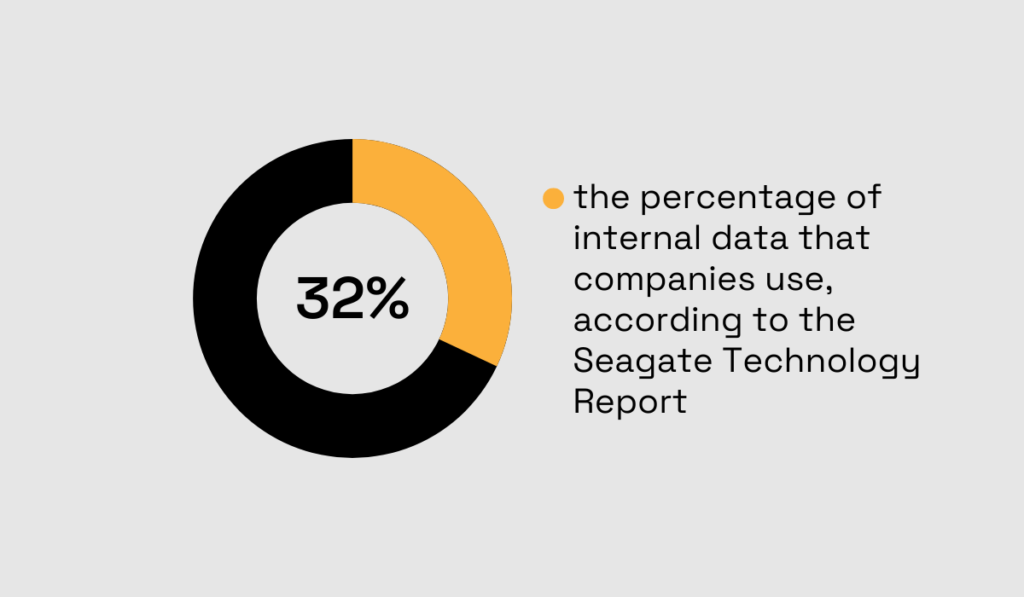
Illustration: Veridion / Data: Seagate
In most cases, the reason behind this is the absence of a data strategy.
So, if you want to get the most out of your data, having a data strategy is more important than merely collecting it.
To define your data strategy, it’s vital to address these key questions:
These five points are crucial for transforming data into valuable sources for improving your procurement operations.
Let’s focus now on how you can define your data strategy step by step.
It would be best if you began by evaluating your existing data infrastructure.
It’s important to understand what data you possess, where it comes from, and its quality. This initial assessment will form the foundation for your data strategy development.
In this phase, also consider data cleansing and implementing overall data control measures, especially if your older data may have become outdated.
Next, it would be wise to define your data driven procurement objectives precisely.
Whether your focus is cost reduction, improved supplier relationships, or risk mitigation, your objectives will shape your data strategy.
In this step, you should follow the SMART framework, making sure that your goals are:
That way you will set goals that you will, in fact, be able to achieve.
For instance, you can set a goal that goes something like this: we will reduce procurement costs by 10% in the next fiscal year.
Internally, your contracts, ERP systems, and supplier databases provide a solid starting point.
Externally, you can tap into web data, news, direct supplier information, government open data, third-party proprietary data, and big data platforms for valuable insights.
Up-to-date data about suppliers on big data platforms can be particularly beneficial for procurement. We’ll talk more about that in the following sections.
Next, you should specify the key metrics that you would track.
Those metrics should be aligned with your procurement goals.
Metrics could encompass cost savings, supplier performance, and more. Pinpoint the few most important ones to start with.
Regardless of which metrics are vital for your procurement operations, measuring them is crucial to keeping track of your organization’s health.
Moreover, closely monitoring these key metrics allows you to find space for improvement in your procurement.
We will address this more in-depth in the later sections.
Identifying data analysis techniques that suit your needs will uncover the skills and tools you require.
A common analysis technique in procurement is predictive modeling, where you can use historical data to predict future demand, pricing trends, or supplier performance.
Or, if you are dealing with unstructured data like emails from suppliers, you can use text analysis to extract information.
Furthermore, a statistical analysis can be helpful for gaining insights into many aspects of procurement.
There are different methods of data analysis, which makes choosing the right one a vital step in creating a data driven procurement strategy.
Your data strategy will work only if other team members understand it.
So, you should contemplate transforming raw data into actionable insights for your team.
If you have to present your data to less technical team members, you can use data visualization to make it more understandable.
Data dashboards and reporting systems that many software tools have (e.g. business intelligence software) can facilitate the practical application of data within your organization.
These were some crucial steps you’d need to take if you want to have a good data strategy.
While defining a data strategy may seem complex at first, it is an essential step toward leveraging data and using it for data driven procurement.
Now, with an established strategy, the next step is to explore which tools can help you collect the data.
Modern procurement software brings the ability to seamlessly capture a wide spectrum of data – from supplier information needed for performance analysis to data needed for spend analysis or ensuring contract compliance.
Furthermore, in periods where timely actions make all the difference, having access to fresh, real-time data is paramount. Software solutions enable just that.
But it seems that not a lot of companies have access to fresh and accurate procurement data.
A recent survey conducted by SpendHQ and Procurious brings a startling fact to light—approximately 75% of companies lack the ability to refresh their procurement data daily or in real time.
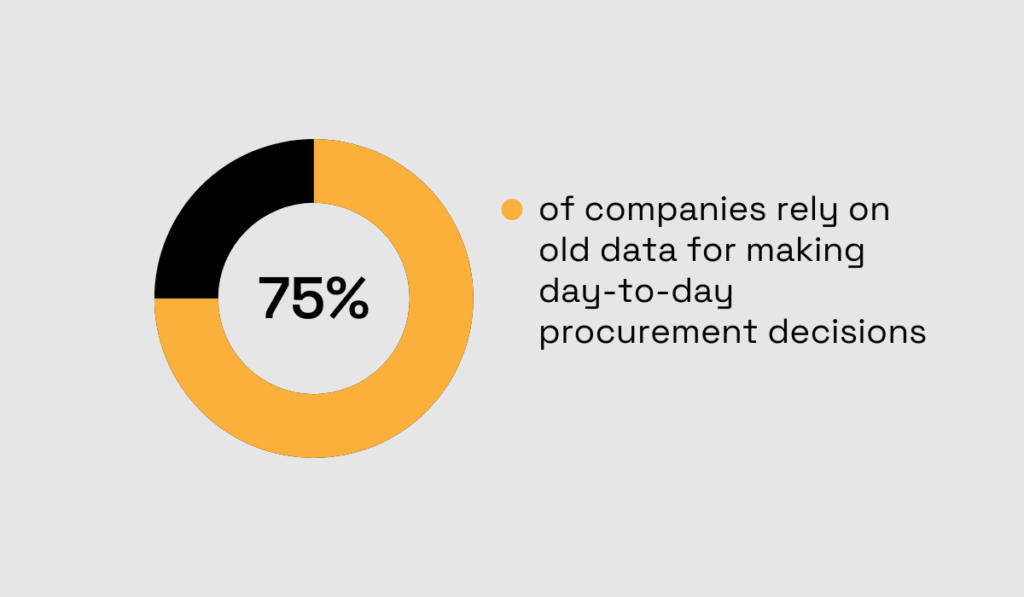
Illustration: Veridion / Data: SpendHQ
This means that many procurement teams find themselves making decisions in the dark, relying on “expired” data sourced from internal records such as old purchase orders, invoices, contracts, and supplier information.
However, relying solely on this dated data is no longer sufficient.
Today’s business landscape is very dynamic and requires companies to be agile and adaptive.
In situations where factors like inflation, rising costs, and supply chain disruptions are the norm, procurement faces unique challenges.
To stay ahead and remain agile, having accurate and up-to-date data you can rely on is essential.
Whether it’s internally or externally sourced, here’s why having reliable data matters:
| Benefit category | Source of data | How it helps |
| Identifying Maverick Spending | Internal data | Helps uncover instances of uncontrolled spending, allowing you to trim costs effectively and stop bad practices. |
| Supplier Evaluation | Internal data | You can assess supplier performance, ensuring you work with the right partners. |
| Faster Supplier Sourcing | External data | Speeds up supplier identification, helping you find suppliers that meet your exact needs. |
| Prioritizing Sustainability | External data | Enables you to source suppliers aligned with Environmental, Social, and Governance (ESG) criteria. |
| Supplier Risk Mitigation | External data | Allows you to identify potential supplier risks and address them. |
If you want to reap all these benefits, you need access to the freshest information. Investing in the right tools becomes crucial to use the power of data.
Here’s one example of how a good tool can help procurement teams access accurate external data and leverage it.
Our AI-powered big data solution, Veridion, offers procurement teams a comprehensive, global supplier database that is regularly updated, ensuring data is never older than two weeks.
Here’s how having such fresh supplier data can transform your procurement:
On top of that, Veridion’s data can be seamlessly integrated with your existing workflows.
So, your team will have easy access to all the data they need to make informed decisions.
Veridion is just one example of how using procurement software enables you to achieve great things by having access to fresh, up-to-date data.
Since data driven procurement isn’t just a current trend but the factor that will ultimately decide whether you remain competitive or not, investing in tools that enable it should, therefore, be a clear choice.
Implementing a successful data driven procurement strategy relies on creating a culture within the procurement department where every employee understands the data and uses its insights to improve decision-making and excel in their roles.
So, how can you create and promote a data driven culture?
First and foremost, start with yourself.
Being a data driven leader who recognizes the importance of data and teaches its employees about it, and on top of that, invests in tools and data skills improvement, is the only way to achieve a data driven procurement culture.
Stijn Christiaens, co-founder of the data intelligence company Colibra, shares his view on data driven culture:
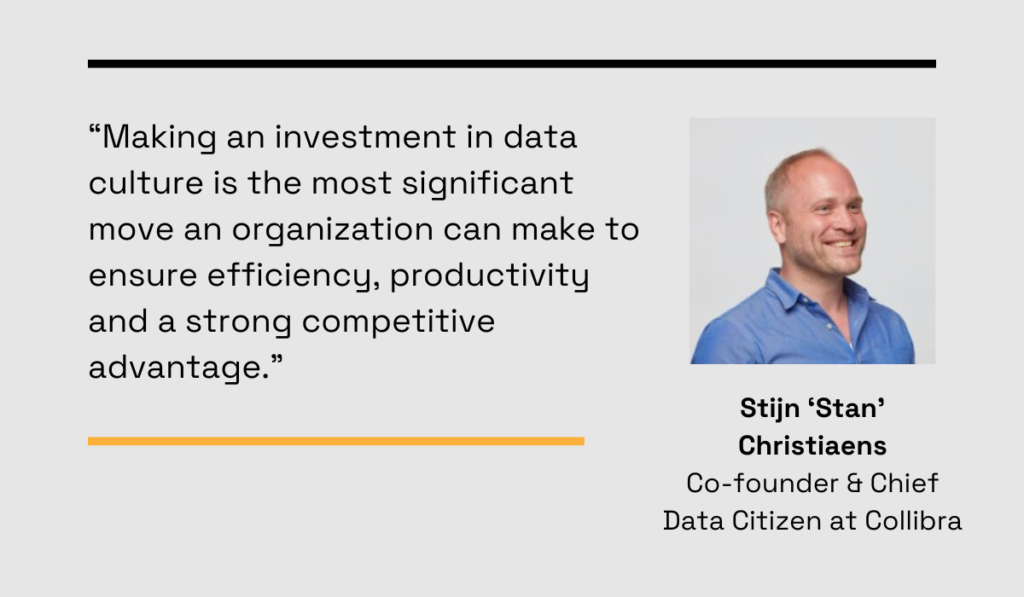
Illustration: Veridion / Quote: Forbes
Christiaens also states that digital transformation is only possible when companies have leadership that prioritizes a data driven culture.
Next is to focus on educating your teams about data and how to leverage its potential effectively.
Practical training is crucial at this point—employees need hands-on experience navigating data sources, interpreting data dashboards, and adeptly using data analytics tools.
In this context, keep in mind that different roles within your organization may require varying levels of data expertise.
So, make sure to customize training programs to suit the specific needs of different team members in the procurement department.
So that each role receives training tailored to their responsibilities.
Finally, focus on creating an environment where employees will feel encouraged to experiment with data driven approaches.
Promote open communication and collaboration, where sharing insights and ideas based on data is the norm.
By combining leadership, education, practical training, and a supportive environment, you can cultivate a culture where data isn’t just a tool but a way of thinking.
Promoting teamwork and collaboration with other departments is crucial when adopting a data driven procurement strategy.
Why?
Because procurement is just one department within the company that doesn’t exist in isolation.
And because data driven procurement can transform other departments as well, and help the company as a whole to be more efficient and successful.
The survey conducted by SpendHQ and Procurious, which we mentioned earlier, also analyzed collaboration between procurement and other departments.
The results revealed that 67% of procurement teams regularly or often collaborate with finance, while 60% engage with supply chain and logistics, as well as IT and operations.
These statistics indicate a positive trend.
However, it is concerning that 43% of all procurement teams rarely, if ever, collaborate with manufacturing in rating performance and establishing outcomes, and 39% never or rarely collaborate with sales and marketing.
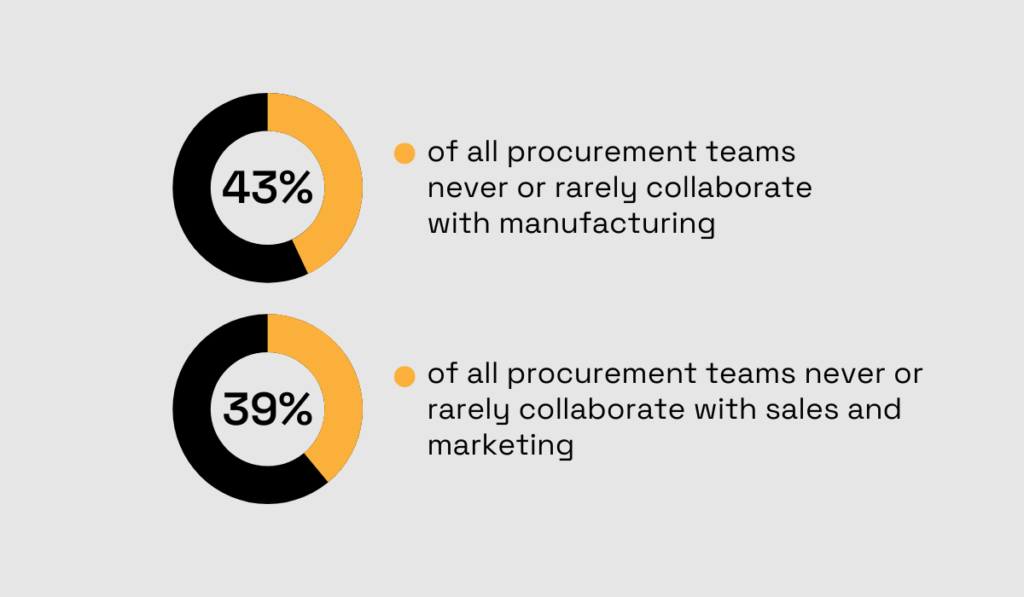
Illustration: Veridion / Data: SpendHQ
Clearly, there is significant room for improving interdepartmental collaboration.
How can this be achieved?
We have prepared a few tips that can help you promote collaboration across departments:
Data obtained within the procurement department can be used to improve many other business areas and can align various departments, making them work better together.
By following these tips, you will be on the right path to creating a collaborative culture and ensuring that data driven culture becomes a shared goal across the whole organization.
We mentioned defining key metrics before, and why they are a vital part of the whole data driven strategy.
Why? Well, only if you measure your KPIs can you see if your data driven procurement strategy brings value to your organization.
In other words, establishing and measuring KPIs can:
That’s why it’s somewhat surprising that 79% of procurement teams lack dedicated procurement performance management software to track and manage their performance.
Let’s now see which KPIs you should measure to evaluate your strategy performance.
The same survey by SpendHQ and Procurious that we mentioned earlier showed that procurement teams most frequently share the following KPIs with senior management:
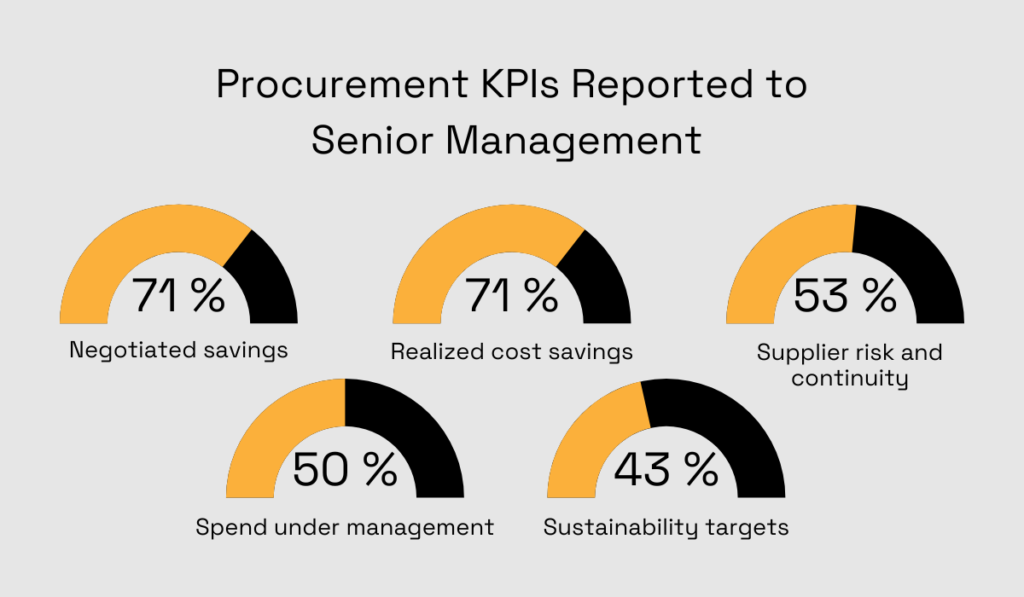
Illustration: Veridion / Data: SpendHQ
As you can see, negotiated savings and realized cost savings are in the lead, followed by supplier risk, spend under management, and sustainability targets.
Apart from these KPIs, it would be wise to measure various aspects of procurement performance, including compliance, quality, accuracy, efficiency, and financial impact.
In the table below, we included five more essential KPIs to measure and explained their purpose:
| Compliance Rate | Measures the extent to which procurement activities adhere to established policies and regulations. Higher compliance rates indicate better governance. |
| Supplier Defect Rate | Assesses the quality of products or services received from suppliers. It tracks the percentage of defects or issues in delivered goods, helping to identify areas for improvement within supplier performance. |
| PO and Invoice Accuracy | Measures the correctness and completeness of purchase orders (POs) and invoices. A high accuracy rate reduces errors, disputes, and processing time, contributing to cost savings and operational efficiency. |
| Supplier Lead Time | Measures the time a supplier takes to fulfill an order after it’s placed. Shorter lead times can reduce inventory costs and improve responsiveness to changes in demand. |
| Procurement ROI | Evaluates the financial performance of procurement activities. It calculates the gains or cost savings achieved through procurement efforts in relation to the investments made. A positive ROI indicates successful procurement strategies. |
In essence, by analyzing your data relative to your KPIs, you are taking a significant step toward a successful data driven procurement strategy that can drive improvement.
A data driven procurement strategy can bring numerous benefits to your organization—such as faster and more informed decision-making, cost-savings, and stronger supplier relationships.
However, realizing these advantages requires procurement executives to clearly define the strategy, and act according to the best practices, such as promoting a data driven culture and encouraging collaboration with other departments.
Additionally, data needs to be collected and connected to the greater goal, which is why incorporating procurement software to collect and transform data into KPIs is essential for measuring your procurement strategy’s success.
We did our best to provide you with the best practices for a successful data driven procurement strategy.
Now integrate them into your data strategy, and fully harness the advantages of data driven procurement.